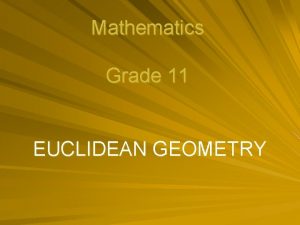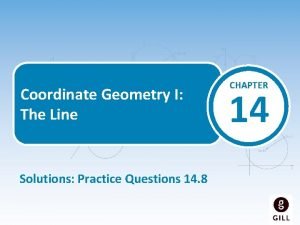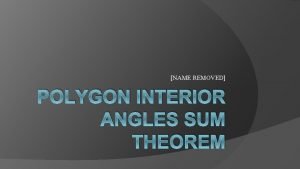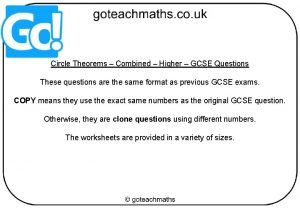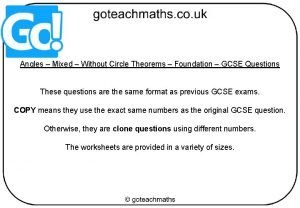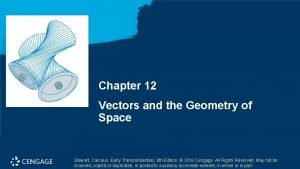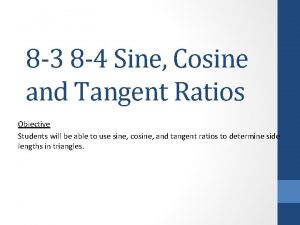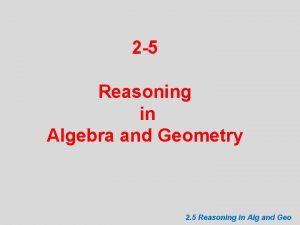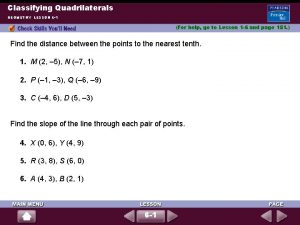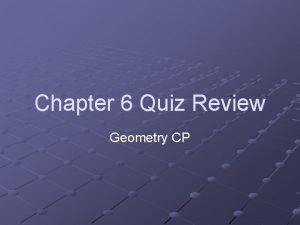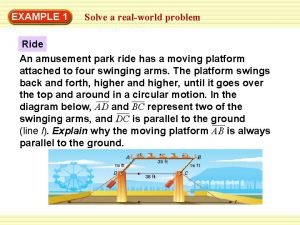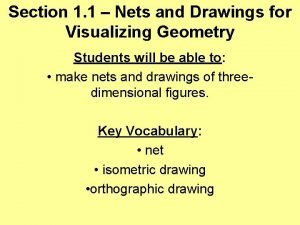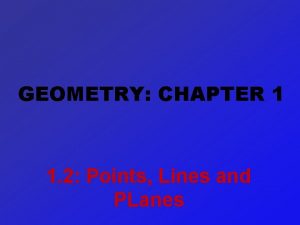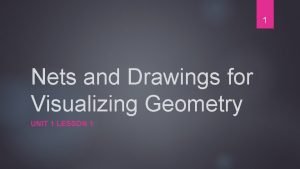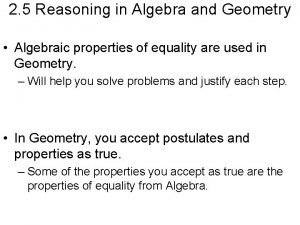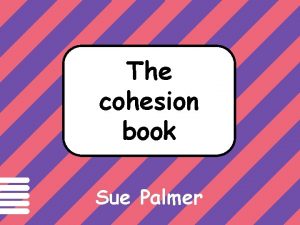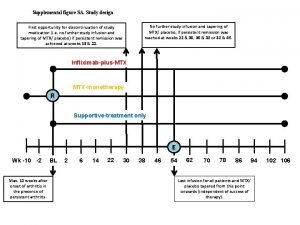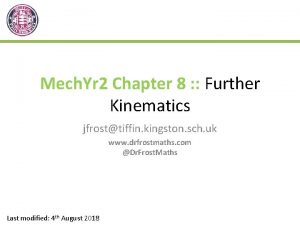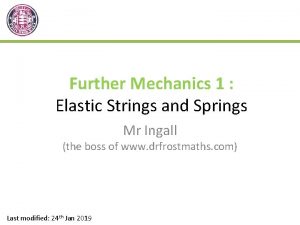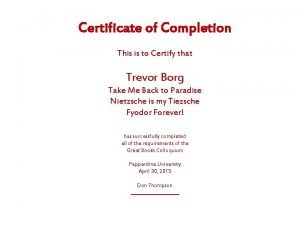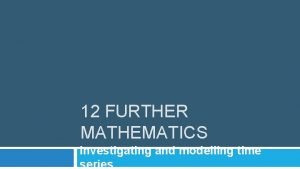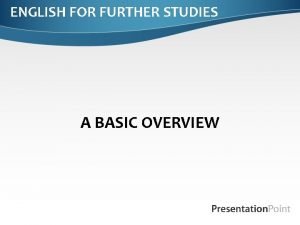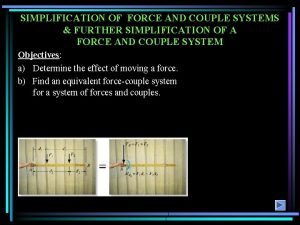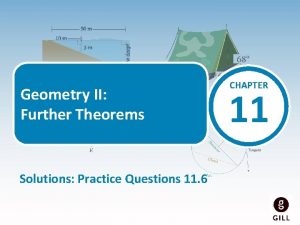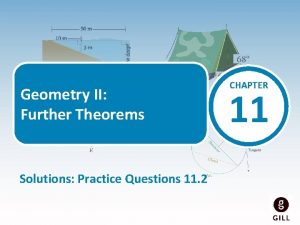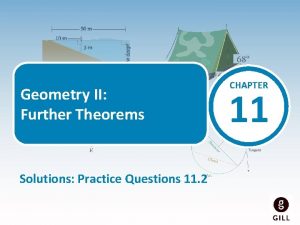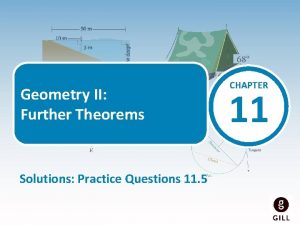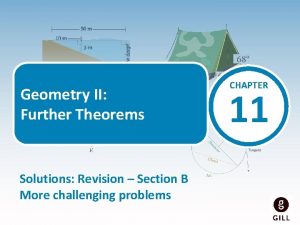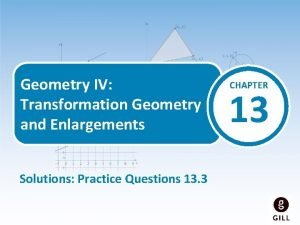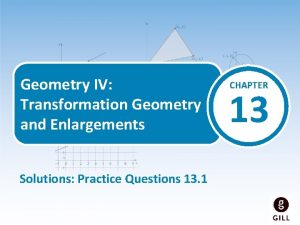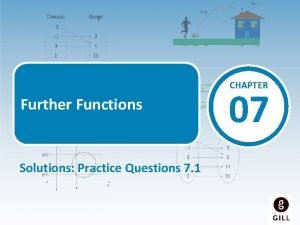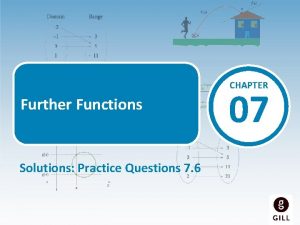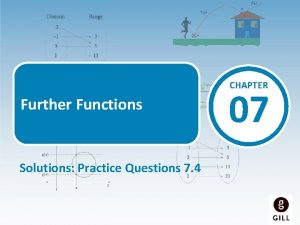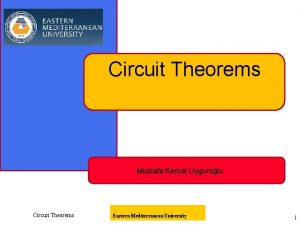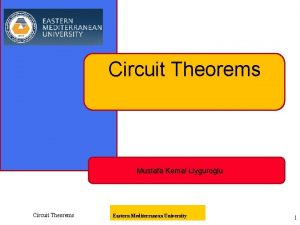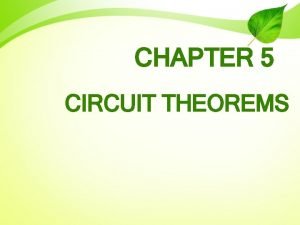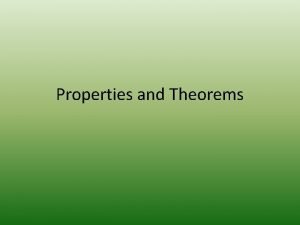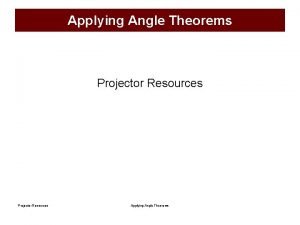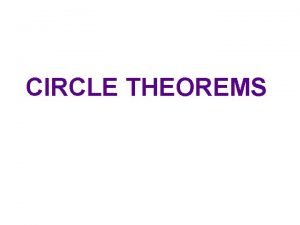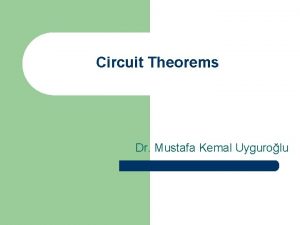Geometry II Further Theorems Solutions Practice Questions 11


































- Slides: 34

Geometry II: Further Theorems Solutions: Practice Questions 11. 3 CHAPTER 11

11 1. Practice Questions 11. 3 Show that the two triangles are similar in each of the following: (i) | ACE| = | BCD| Same angle | CAE| = | CBD| Given Two angles are equal; the triangles are similar.

11 1. Practice Questions 11. 3 Show that the two triangles are similar in each of the following: (ii) | HGF| = | HKJ| Given | GHF| = | JHK| Vertically opposite Two angles are equal; the triangles are similar.

11 1. Practice Questions 11. 3 Show that the two triangles are similar in each of the following: (iii) | DFH| = | EFG| Same angle | DHF| = | EGF| Corresponding angle | HDF| = | GEF| Corresponding angle DFH is equiangular to EFG and therefore the triangles are similar.

11 1. Practice Questions 11. 3 Show that the two triangles are similar in each of the following: (iv) | ACE| = | BCD| Same angle | CAE| = | CBD| Given Two angles are equal; the triangles are similar.

11 1. Practice Questions 11. 3 Show that the two triangles are similar in each of the following: (v) | VYU| = | VXW| Given | UVY| = | XVW| Vertically opposite Two angles are equal; the triangles are similar.

11 1. Practice Questions 11. 3 Show that the two triangles are similar in each of the following: (vi) | JLK| = | MLN| Vertically opposite | LKJ| = | LMN| Alternate angles Two angles are equal; the triangles are similar.

11 2. Practice Questions 11. 3 A company makes tents of different sizes and colours. Use the information shown in the diagrams to decide whether the triangular faces of these tents are similar. Justify your answer. 68 + 44 + x = 180 3 angles in a triangle 112 + x = 180 112 + x − 112 = 180 − 112 x = 68 red tent Subtract 112 from both sides

11 2. Practice Questions 11. 3 A company makes tents of different sizes and colours. Use the information shown in the diagrams to decide whether the triangular faces of these tents are similar. Justify your answer. Similarly, for the green tent 68 + x = 180 3 angles in a triangle 136 + x = 180 136 + x − 136 = 180 − 136 x = 44 Subtract 136 from both sides

11 2. Practice Questions 11. 3 A company makes tents of different sizes and colours. Use the information shown in the diagrams to decide whether the triangular faces of these tents are similar. Justify your answer. The triangles are equiangular and are therefore similar triangles.

11 3. (i) Practice Questions 11. 3 In the shape ABCD, AB || DC, AD || BC and |EC| is 5 units. |AE| = 4 units and |EB| = 2 units, as shown. Identify a pair of similar triangles in the diagram. EFB and DFC are similar.

11 3. Practice Questions 11. 3 In the shape ABCD, AB || DC, AD || BC and |EC| is 5 units. |AE| = 4 units and |EB| = 2 units, as shown. X X (ii) Explain why the triangles you named are similar. | EFB| = | DFC| Vertically opposite | FBE| = | FDC| Alternate angles | FEB| = | FCD| Alternate angles

11 3. (iii) Practice Questions 11. 3 In the shape ABCD, AB || DC, AD || BC and |EC| is 5 units. |AE| = 4 units and |EB| = 2 units, as shown. Find the length of |FC|. |EB| corresponds to |DC| |BF| corresponds to |FD| |EF| corresponds to |FC| |EB| = 2 Given |DC| = |AB| = 6 Parallelogram

11 3. (iii) Practice Questions 11. 3 In the shape ABCD, AB || DC, AD || BC and |EC| is 5 units. |AE| = 4 units and |EB| = 2 units, as shown. Find the length of |FC|. If EFB and DFC are similar, then

11 3. (iii) Practice Questions 11. 3 In the shape ABCD, AB || DC, AD || BC and |EC| is 5 units. |AE| = 4 units and |EB| = 2 units, as shown. Find the length of |FC|. If EFB and DFC are similar, then

11 3. (iii) Practice Questions 11. 3 In the shape ABCD, AB || DC, AD || BC and |EC| is 5 units. |AE| = 4 units and |EB| = 2 units, as shown. Find the length of |FC|. If EFB and DFC are similar, then

11 4. Practice Questions 11. 3 By firstly showing the triangles are similar, find x in each of the following: (i) | DAE| = | BAC| same angle | ADE| = | ABC| corresponding | AED| = | ACB| corresponding The triangles are similar.

11 4. (i) Practice Questions 11. 3 By firstly showing the triangles are similar, find x in each of the following:

11 4. Practice Questions 11. 3 By firstly showing the triangles are similar, find x in each of the following: (ii) | PQR| = | RST| given | PRQ| = | TRS| vertically opposite. The triangles are similar.

11 4. (ii) Practice Questions 11. 3 By firstly showing the triangles are similar, find x in each of the following:

11 4. Practice Questions 11. 3 By firstly showing the triangles are similar, find x in each of the following: (iii) | UVZ| = | XYZ| given | UZV| = | XZY| same angle The triangles are similar.

11 4. (iii) Practice Questions 11. 3 By firstly showing the triangles are similar, find x in each of the following:

11 4. Practice Questions 11. 3 By firstly showing the triangles are similar, find x in each of the following: (iv) | SRQ| = | PTQ| given | SQR| = | PQT| vertically opposite The triangles are similar.

11 4. (iv) Practice Questions 11. 3 By firstly showing the triangles are similar, find x in each of the following:

11 4. Practice Questions 11. 3 By firstly showing the triangles are similar, find x in each of the following: (v) | UXV| = | YXZ| same angle | XUV| = | XYZ| corresponding | XVU| = | XZY| corresponding The triangles are similar.

11 4. (v) Practice Questions 11. 3 By firstly showing the triangles are similar, find x in each of the following:

11 4. Practice Questions 11. 3 By firstly showing the triangles are similar, find x in each of the following: (vi) The triangles are similar since the have a common angle and both have an angle of 80 o.

11 5. Practice Questions 11. 3 On the shoe rack shown, |BA| = 33 cm, |CB| = 27 cm, |CD| = 44 cm, and |DE| = 25 cm. Investigate whether the shelf [BD] is parallel to the floor [AE]. Use the converse of theorem. Converse of Theorem: If a line divides two sides of a triangle proportionally, then it is parallel to the third side. The shelf is not parallel to the floor.

11 6. Practice Questions 11. 3 Sam wants to measure the height of a vertical climbing wall in his local park. He decides to measure the length of his shadow and the shadow cast by the wall at the same time of day. The shadow cast by the wall is 8· 4 m. His shadow is 3· 1 m. If his height is 1· 7 m, what is the height of the wall? Since the sun’s rays are parallel, these triangles are similar.

11 7. Practice Questions 11. 3 The height of the net in tennis is 0· 9 m and the service line is 6 m from the net. From what height will a player serve the ball so that it will just pass over the net and land 2 m from the net?

11 8. (i) Practice Questions 11. 3 Chloe is 1· 5 m tall. Her shadow is 3· 5 m long. She notices that the end of her shadow, the top of her head, and the top of a building are in a straight line. The building is 28 m tall. Draw a sketch to represent this situation.

11 8. (ii) Practice Questions 11. 3 Chloe is 1· 5 m tall. Her shadow is 3· 5 m long. She notices that the end of her shadow, the top of her head, and the top of a building are in a straight line. The building is 28 m tall. Use your sketch to work out how far she is from the building.

11 9. Practice Questions 11. 3 A father and son are standing side by side. How tall is the son if the father is 1· 8 m tall and casts a shadow 3· 2 m long, while his son’s shadow is 2· 4 m long? Multiply both sides by 1· 8 x= x = 1· 35 m

11 10. Practice Questions 11. 3 Two extension ladders are leaning at the same angle against a vertical wall. The 3 m ladder reaches 2· 4 m up the wall. How much farther up the wall does the 8 m ladder reach? Multiply both sides by 2· 4 x + 2· 4 = 6· 4 x + 2· 4 − 2· 4 = 6· 4 − 2· 4 x=4 m Subtract 2· 4 from both sides
 Euclidean geometry grade 11 theorem 1
Euclidean geometry grade 11 theorem 1 Coordinate geometry practice questions
Coordinate geometry practice questions Polygon interior angle sum theorem
Polygon interior angle sum theorem Circle theorems gcse questions
Circle theorems gcse questions Gcse
Gcse Electron geometry and molecular geometry
Electron geometry and molecular geometry 4 electron domains 2 lone pairs
4 electron domains 2 lone pairs Bonding theories
Bonding theories A 100 lb weight hangs from two wires
A 100 lb weight hangs from two wires Chapter 12 vectors and the geometry of space solutions
Chapter 12 vectors and the geometry of space solutions Cosine tangent sine
Cosine tangent sine 2-5 practice reasoning in algebra and geometry answer key
2-5 practice reasoning in algebra and geometry answer key Practice 6-1 classifying quadrilaterals answers
Practice 6-1 classifying quadrilaterals answers Chapter 6 practice test geometry
Chapter 6 practice test geometry 1-1 exercises guided practice geometry
1-1 exercises guided practice geometry Nets and drawings for visualizing geometry
Nets and drawings for visualizing geometry Geometry chapter 1 points lines and planes
Geometry chapter 1 points lines and planes Nets and drawing for visualizing geometry
Nets and drawing for visualizing geometry 2-5 reasoning in algebra and geometry
2-5 reasoning in algebra and geometry Cohesion
Cohesion Further study design
Further study design Strong iron post on a ship deck for working fastening lines
Strong iron post on a ship deck for working fastening lines Dr frost further kinematics
Dr frost further kinematics Spring problems mechanics
Spring problems mechanics Not for distribution confidential
Not for distribution confidential Certificate sentence
Certificate sentence Further applications of integration
Further applications of integration Further applications of integration
Further applications of integration Time series further maths
Time series further maths Havering college of further and higher education
Havering college of further and higher education Life is a highway metaphor
Life is a highway metaphor English for further studies
English for further studies Further applications of integration
Further applications of integration Letter asking for information about a course
Letter asking for information about a course Couple systems
Couple systems
